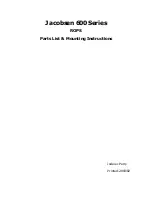
13
6.0 MAINTENANCE, SERVICE, and STORAGE
;
Do not clean and disinfect the
Lanyards
by any method other than described in the following “Cleaning
Instructions”. Other methods may have adverse effects on the
Lanyards
or user.
6.1 CLEANING:
Cleaning procedures for Restraint Lanyard are as follows:
•
Periodically clean the exterior of the Lanyard using water and a mild soap solution. Water temperature must not
exceed 40 °C (104 °F). Position the Lanyard so excess water can drain out. Do not dry-clean. Do not iron. Clean
labels as required.
•
Clean the Web Lifeline with water and mild soap solution. Rinse and thoroughly air dry. Do not force dry with
heat. The lifeline should be dry before allowing it to retract into the housing. An excessive buildup of dirt, paint,
etc. may prevent the lifeline from fully retracting back into the housing causing a potential free fall hazard.
;
Use a bleach-free detergent when cleaning the
Lanyards
. Fabric softener or dryer sheets SHOULD NOT be
used when cleaning and drying the
Lanyards
6.2 SERVICE:
Lanyards are not repairable. If the Lanyard has been subjected to any damage or fall force, or inspection
reveals an unsafe or defective condition, remove the Lanyard from service and discard.
6.3 STORAGE/TRANSPORT:
Store and transport Lanyards in a cool, dry, clean environment out of direct sunlight. Avoid
areas where chemical vapors may exist. Thoroughly inspect the Lanyard after any period of extended storage.
7.0 LABELS
Figure 11 illustrates labels on the the Restraint Lanyards and their locations. All labels must be present on the Lanyard.
Information on each label is as follows:
Figure 11 Reference: Description:
1
Model number
2
Serial number
3
Batch number
4
Address of the Manufacturer
5
Read these instructions before using the Rope Grab
6
European standard
7
CE Marking of European Conformity
8
Number of Notified body carrying out Conformity to type
9
Length
10
Month of manufacture
11
Year of manufacture
12
Web Address of the Manufacturer
13
Rope Diameter
14
Capacity














































